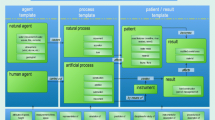Abstract
This paper proposes a parallel and distributed computational model called Cellular Frame Model for hierarchical labelling of partial and global parts of images by words. The labelling is regarded as a process for integrating images and words. An objective model world is described by defining a set of labels ordered in a hierarchy by means of a Cellular Frame knowledge representation. The existence reliability of each label is determined for each location of an array in the Frame. It is determined by a state equation whose initial condition is given by an input primitive label-pattern. The state equation is of the form of local, parallel and iterative computation. The computational process described by the state equation is considered as a process of aggregation (based on input label patterns) of label knowledge introduced for the model description. In this paper, the model description of the Cellular Frame is discussed from two viewpoints: (1) label hierarchy and (2) graphical interpretation of the model. Convergence of the labelling process is ensured by the fact that the state equation always converges. In addition, several hypotheses have been ascertained by showing an example model and a simulation of the labelling process by a state equation.
Similar content being viewed by others
Explore related subjects
Discover the latest articles, news and stories from top researchers in related subjects.References
Ballard, D. H. & Brown, C. M. (1982).Computer Vision. Prentice-Hall Inc.: New Jersey.
Davis, L. S. & Rosenfeld, A. (1978). Hierarchical Relaxation for Waveform Parsing. In Hanson, A. R. & Riesman, E. M. (eds.)Computer Vision Systems. Academic Press: New York.
Feldman, J. A. (1985). Connectionist Models and Parallelism in High Level Vision.Computer Vision and Image Processing 31: 178–200.
Joshi, A. K. (1991). Natural Language Processing.Science 253: 1242–1249.
Landy, M. S. & Hummel, R. A. (1986). A Brief Survey of Knowledge Aggregation Methods. In Proceedings ofThe Eighth International Conference on Pattern Recognition, 248–252.
Marr, D. (1982).Vision. W. H. Freeman and Company: New York.
Matsuyama, T. (1984). Knowledge Organization and Control Structure in Image Understanding. In Proceedings ofThe Seventh International Conference on Pattern Recognition, 1118–1127.
Nagao, N. (1984). Control Strategies in Pattern Analysis.Pattern Recognition 17(1): 45–56.
Oka, R. (1982). Extraction of Cell Features from Images.Trans. Institute Electronics Communication Engineers J65-D(6): 1219–1226.
Poggio, T. & the Staff (1987). MIT Progress in Understanding Images. In Proceedings ofImage Understanding Workshop, 41–54.
Ray, H. A. (1947). ‘Curious George’, Houghton Mifflin Company: Boston.
Rosenfeld, A., Hummel, R. A. & Zucker, S. W. (1976). Scene Labeling by Relaxation Operations.IEEE Trans. System, Man and Cybernetics 16: 420–433.
Sakaue, K., Tamura, H. & Takagi, M. (1980). Overview of Image Processing Algorithms.Bull of Electrotechnical Laboratory 44(7–8): 43–55.
Toriwaki, J. & Yokoi, S. (1980). Algorithms of Image Processing.Japanese Information Processing Society, Japan21(6): 613–619.
Tsotsos, J. K. (1981). Temporal Event Recognition — An Application of Left Ventricular Performance. In Proceedings ofThe Seventh International Joint Conference on Artificial Intelligence, 900–907.
Yamada, H., Yamamoto, K. & Hosokawa, K. (1993). Directional Mathematical Morphology and Reformalized Hough Transformation Analysis of Topographic Maps.IEEE Trans., Pattern Analysis and Machine Intelligence 15(4): 380–387.
Young, D. (1954). Iterative Methods for Solving Partial Differential Equation of Elliptic Type.Transactions of the American Mathematical Society 76: 92–111.
Zucker, S. W. (1976). Relaxation Labelling and the Reduction of Local Ambiguities. In Proceedings ofThe Third International Conference on Pattern Recognition, 852–861.
Author information
Authors and Affiliations
Rights and permissions
About this article
Cite this article
Oka, R. Hierarchical labelling for integrating images and words. Artif Intell Rev 8, 123–145 (1994). https://doi.org/10.1007/BF00849070
Issue Date:
DOI: https://doi.org/10.1007/BF00849070




